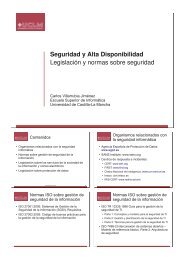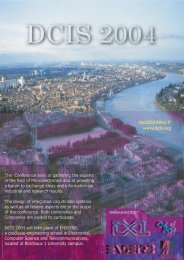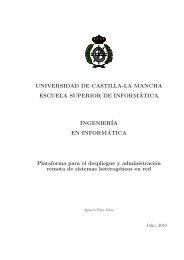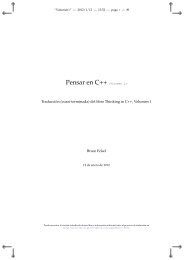MarÃa José Santofimia Romero - Grupo ARCO - Universidad de ...
MarÃa José Santofimia Romero - Grupo ARCO - Universidad de ...
MarÃa José Santofimia Romero - Grupo ARCO - Universidad de ...
You also want an ePaper? Increase the reach of your titles
YUMPU automatically turns print PDFs into web optimized ePapers that Google loves.
lyzed from the point of view of the shortages or weaknesses they are inten<strong>de</strong>d to solve, the approachesand solutions they propose and the <strong>de</strong>tails they have also overlooked. In the following lines, theseprojects and the architectures and approaches they propose are assessed from the perspective of twoof the major concerns that this thesis is trying to cope with: a) how to <strong>de</strong>al with novel or unexpectedsituations; and b) how to implement the ad-hoc system behaviors that are supposed to lead the environmentto the <strong>de</strong>sired state. Nevertheless, these challenges have been overlooked for the majority ofthe approaches for Ambient Intelligence and, traditionally, attention in this field has been addressedto different concerns, such as to those related to human-centered computing, network managementissues, service discovery and management, or Quality of Service, among the most relevant.It is a general trend, among the following surveyed work, that <strong>de</strong>spite successfully coping withsome of the aforementioned common concerns, they tend to make simple assumptions about the setof situations that they are consi<strong>de</strong>ring, therefore ignoring the possibility of unpredictable situationsto take place. In addition to this, the spectrum of possible system responses implemented by theseapproaches is fixed and static, rather than being subject to the requirements and peculiarities of thespecific ongoing situation. Despite having overlooked the management of unpredicted situations orthe implementation of flexible responses, the surveyed projects have ma<strong>de</strong> breakthrough contributionsto the field of Ambient Intelligence, and they are quite <strong>de</strong>finitely the groundings upon which this andfuture works have to be built upon.To start with, the emblematic MIT project called Oxygen 1 was one of the main and most successfulapproaches to the problem of pervasiveness. This project was mainly <strong>de</strong>voted to simplifyingcomputer interaction, in such a way that efforts were addressed to achieve an interaction paradigm as“pervasive as the air”. The relevance of this project is groun<strong>de</strong>d in the fact that it was one of the firstserious attempts to achieve a pervasive environment, based on the combination of the technologiesthat were populating the environment. Moreover, this project is mainly motivated by the <strong>de</strong>sire to <strong>de</strong>visean interaction style that resembles the one that humans naturally use. In this sense, the intentionis that rather than having to adapt human interaction patterns to those offered by machines, communicationroutines adapted to humans are provi<strong>de</strong>d. Basically, the Oxygen project can be consi<strong>de</strong>redas one of the firsts project aimed at placing humans at the core of computing.The main focus of this project was to <strong>de</strong>termine how to overcome the technical challenges thatwere involved in the advocated vision. The proposed approach consists in consi<strong>de</strong>ring the environmentas a combination of eight different technologies, each of which is specifically <strong>de</strong>signed toaddress certain user needs. The different sets of technologies are arranged in such a way that interactionsare offered in an easy-to-use and adaptable way, exploiting the benefits <strong>de</strong>rived from thedifferent technology cooperation as well as from the enhanced access to information based on customizedinformation about user preferences.Despite the fact that this project was not originally conceived to address Ambient Intelligence, itis worth noticing that the contributions it ma<strong>de</strong> have been foundational for the majority of the projectsproposed for Ambient Intelligence.The Computers in the Human Interaction Loop (CHIL) [147] project is proposed by a consortiumof 15 research laboratories. The focus of this project is on how humans interact with computers,and how to turn this interaction into a more natural mechanism of communication in which people’sattention is not drawn to the artifact, but on the contrary, it is the artifact’s responsibility to focus onhumans and their interactions.Improving the interaction loop, in such a way that it comes to resemble human to human interac-1 http://oxygen.csail.mit.edu/Overview.html17
















